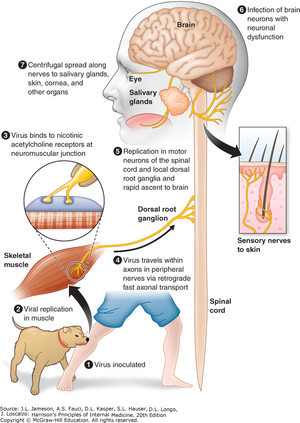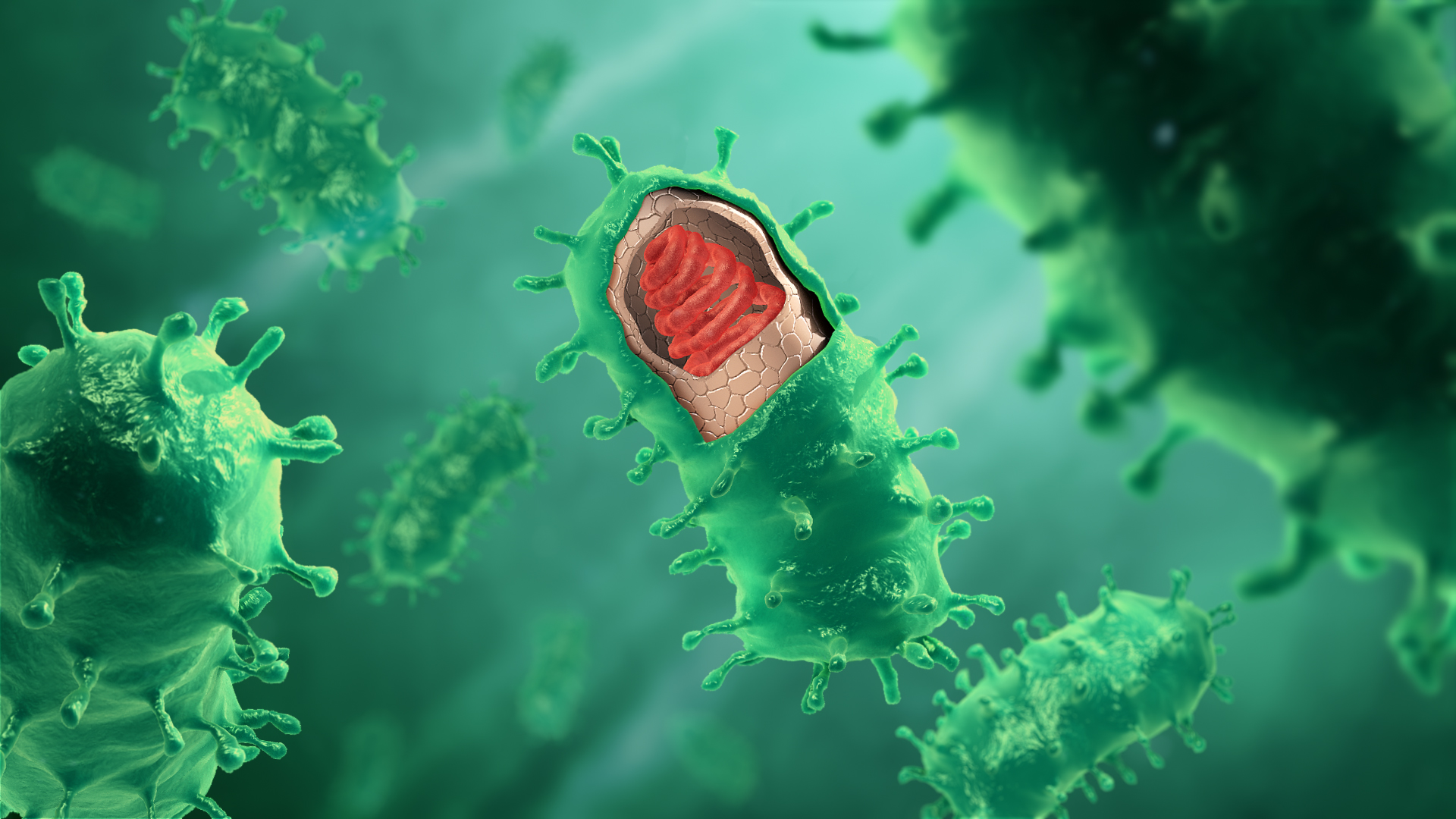Which Unique Form Does The Rabies Virus Take
The animal has no signs of illness during this time. Rabies virus is the cause of the disease called Rabies.

The Spread And Evolution Of Rabies Virus Conquering New Frontiers Abstract Europe Pmc
Hydrophobia is a unique characteristic of rabies in humans.

Which unique form does the rabies virus take. Rabies virus binds to nicotinic acetylcholine receptors at the neuromuscular junction and travels toward the spinal cord within axons of peripheral nerves by. Rabies is a viral infection of the brain that is transmitted by animals and that causes inflammation of the brain and spinal cord. The rabies virus causes the disease by infecting nerves in animals and people.
D The modern rabies vaccine is grown in human diploid cells from an aborted embryo. The Rabies virus is part of the Rhabdovirus family. Rabies is famous for its unique form by extreme behavioral changes including aggression and attack behavior lets call it the angry or furious form of this virus.
There are two clinical manifestations of rabies. All viruses of the Rhabdovirus family are bullet shaped viruses that are each approximately 180 x 70nm nano metres. Rabies is caused by a virus that affects the central nervous system particularly causing inflammation in the brain.
Rabies virus is inoculated into muscle and subcutaneous tissues in the saliva of a biting animal Figure 1There is a delay in movement of the virus at the site of inoculation during the incubation period that lasts for weeks to months. West Caucasian bat lyssavirus Ikoma lyssavirus and Lleida bat lyssavirus form independent phylogroup 3. Researchers found that the rabies virus travels through neurons differently than other neuron-invading viruses and that its journey can be stopped by a.
Rabies virus RABV is a highly neurotropic virus in infected animals and humans. Rabies is a viral disease transmitted from mammals to humans that causes an acute encephalitis. It is mainly transmitted by bites of infected dogs and bats and racoons.
The unique feature of Rabies virus is that it is a BULLET shaped virus. Once symptoms of the disease develop either form is almost always fatal. The rabies virus travels to the brain through nerves inside the brain the virus reproduces and then it travels back through the nerves to most parts of the body.
The Rabies virus is a bullet shaped encephalitis virus causing inflammation of the brain virus that attacks the healthy cells within its hosts humans and mammals upon entry. Rabies virus is most commonly transmitted through the bite of an infected mammal all of which may be susceptible but to greatly varying degrees. This process can last approximately 3 to 12 weeks.
When it reaches the brain the virus multiplies rapidly and passes to the salivary glands. Eventually the virus reaches the salivary glands where it is released into the saliva in the mouth. The rabies antibody in the dFA test is primarily directed against the nucleoprotein of the virus.
Rabies virus is transmitted through direct contact such as through broken skin or mucous membranes in the eyes nose or mouth with saliva or brainnervous system tissue from an infected animal. The other type of this virus can cause something called paralytic rabies. Rabies is transmitted through mucosal.
Rabies virus from the infected saliva enters the wound. The virus may enter the peripheral nervous system directly or may replicate in muscle tissue after entering the host remaining at or near the site of introduction for most of the incubation period. Following inoculation the virus replicates in the striated or connective tissue at the site of inoculation and enters the peripheral nerves through the neuromuscular junction.
Virus infection in humans causes alternating symptoms of depression and agitation and almost invariably leads to extreme types of violent behavior and death. Rabies virus travels through the nerves to the spinal cord and brain. Furious rabies is the most common form of human rabies.
People usually get rabies from the bite of a rabid animal. Domestic dogs cats and rabbits and wild animals such as skunks raccoons. The virus is similar to VSV of cattle.
Phylogroup 2 includes Lagos bat lyssavirus Mokola lyssavirus and Shimoni bat lyssavirus. Rabies virus replicates in the cytoplasm of cells and infected cells may contain large round or oval inclusions containing collections of nucleoprotein N or smaller collections of antigen that appear as dust-like fluorescent particles if stained by the dFA procedure. Once the virus reaches the spinal cord and brain rabies is almost always fatal.
Rabies virus RABV the prototype lyssavirus is responsible for the vast majority of all human rabies. Rabies is an acute infection of the CNS which is almost invariably fatal.

Figure1 Rabies Virus Shape And Its Structures Source H T T P S Download Scientific Diagram

Typical Representation Of The Pathogenesis Of Rabies Virus Where The Download Scientific Diagram

The Spread And Evolution Of Rabies Virus Conquering New Frontiers Abstract Europe Pmc

Figure1 Rabies Virus Shape And Its Structures Source H T T P S Download Scientific Diagram

Rabies Virus An Overview Sciencedirect Topics

Rabies Virus An Overview Sciencedirect Topics



Post a Comment for "Which Unique Form Does The Rabies Virus Take"